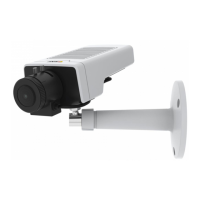
Do you have a question about the Axis Mk II Series and is the answer not in the manual?
| Resolution | 1920x1080 |
|---|---|
| Minimum Illumination | 0.1 lux |
| Day/Night | Yes |
| Compression | H.264 |
| Ethernet Port | 10BASE-T/100BASE-TX |
| Power over Ethernet | Yes (PoE) |
| Operating Temperature | -40 °C to 50 °C |
| Ingress Protection | IP66 |
| Weight | Varies by model |
Enables installers to fine-tune the camera view during setup without login.
Locate Axis devices on the network and assign IP addresses using Axis tools.
Lists supported web browsers for accessing the device's interface.
Steps to access and navigate the device's web interface.
Procedure for setting up the initial administrator account for device security.
Recommendations for creating and managing strong, secure passwords.
Ensuring the device's firmware integrity and authenticity.
Configure fundamental settings like power line frequency and image orientation.
Step-by-step guide for replacing the camera lens.
Adjusting image parameters like level grid and exposure mode for optimal quality.
Utilize Wide Dynamic Range (WDR) for improved visibility in high-contrast scenes.
How to use the pixel counter to check image resolution in specific areas.
Create privacy masks to obscure sensitive areas in the video stream.
Adding custom images as overlays onto the video stream.
Displaying text overlays triggered by events like motion detection.
Configure settings for viewing live video and recording footage.
Optimize bandwidth and storage using compression and Zipstream.
Configure network storage solutions for saving recordings.
Set up automatic recording triggered by object detection events.
Configure audio detection to trigger video recordings.
Set up camera tampering detection and email notifications.
Monitor device status, including security and time synchronization.
View essential device information like firmware version and serial number.
Control live video playback, freezing, and snapshot capture.
Access advanced video settings like format, adaptive stream, and level grid.
Configure capture mode, mounting, frequency, and rotation for installation.
Adjust image appearance: scene profiles, saturation, contrast, brightness.
Fine-tune color balance and light environment settings for accurate colors.
Configure IR-cut filter and threshold for automatic day-to-night transitions.
Select exposure modes (auto, manual, flicker-free) for optimal image capture.
Define zones to optimize exposure calculation in specific areas of the scene.
Apply image corrections like barrel distortion and lens distortion removal.
Enable image stabilization to reduce blur in environments with vibration.
Configure video stream settings: resolution, frame rate, and compression.
Optimize bitrate and storage using Zipstream technology.
Manage video stream bitrate using variable, maximum, or average settings.
Add text or image overlays to video streams.
Create masks to hide sensitive areas in video streams.
Configure audio input, output, and enhancement settings.
Manage and play back recorded video files.
Install and manage applications on the device.
Configure system settings like date, time, and location.
Configure network settings: IPv4, IPv6, hostname, and DNS.
Enable protocols like Bonjour and UPnP for network discovery.
Configure Simple Network Management Protocol for remote management.
Manage certificates and secure connections for device authentication.
Manage user accounts, privileges, and access permissions.
Create rules and conditions to trigger actions based on events.
Configure recipients for notifications via FTP, HTTP, HTTPS, or email.
Manually trigger rules for testing during installation.
Integrate the device with IoT systems using the MQTT protocol.
Configure MQTT client connection details to a broker.
Configure network storage for saving recordings and managing shares.
Create custom stream profiles for specific video stream configurations.
Configure ONVIF users and media profiles for interoperability.
Manage metadata producers and enable metadata streaming.
Configure camera tampering and audio detection.
Pair network speakers or microphones for audio functionality.
View device reports, system logs, and access logs.
Capture network traces for troubleshooting network issues.
Perform maintenance: restart, restore, and factory default reset.
Upgrade the device firmware to the latest version.
Understand bitrate control methods for managing bandwidth.
Configure view areas to focus on specific parts of the scene.
Learn about creating and managing privacy masks.
Details on adding text or image overlays to video streams.
Explore video compression formats like Motion JPEG and H.265.
Information on AXIS Camera Application Platform (ACAP).
Overview of the camera's physical components and features.
Interpret the meaning of the device's status LED indicators.
Information and precautions for using the SD card slot.
Details on the control button functions.
Specifications for network, audio, and I/O connectors.
Step-by-step guide to reset the device to factory default settings.
Understanding active and LTS firmware tracks.
How to check the device's current firmware version.
Important considerations and procedures for upgrading firmware.
Troubleshooting common problems like IP address or firmware upgrade issues.
Factors affecting device performance and how to optimize them.
Provides links to support resources and contact information.